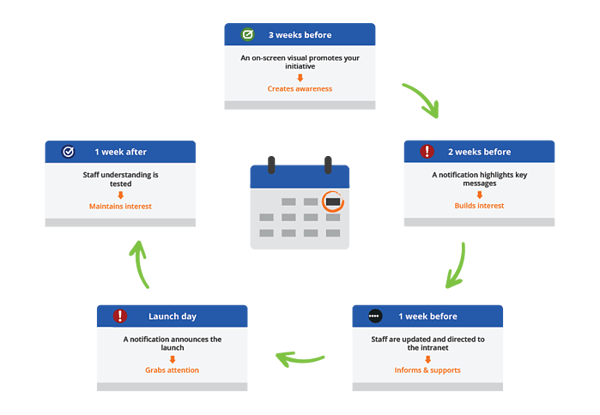
Hybrid working and flexible hours have become the new norm for workers. But this increased flexibility has created a problem for HR Managers – how to build company culture when so many staff aren’t around.
As organizations strive for competitive advantage after the pandemic, culture will play an essential role in motivating and retaining staff. Employees who view their company culture as positive are nearly 4 times more likely to be engaged at work.
But those organizations with a toxic culture will find themselves at a big disadvantage. A toxic workplace culture is over 10 times more likely to contribute to an employee quitting, according to recent research.
Simply put, your company culture defines whether an employee wants to work for you or not.
Here’s what defines company culture, what causes a toxic culture, and how to create a positive culture that your employees will love – and your rivals will envy.
What is Company Culture?
Company culture is the attitudes and behaviors that define the tone of a workplace. It’s shaped by all the interactions staff have with their employer and each other. Culture can be either positive or negative, or any degree in between. It’s a key ingredient of employee experience.
Company culture is important because it heavily influences workplace morale, employee retention and organizational growth. Research has shown that culture is a bigger predictor of whether employees stay or leave an organization than compensation or burnout.
A positive culture provides an environment where motivated staff are invested in doing great work. But a negative culture fosters dissatisfaction and disengagement, which leads to low performance and high employee turnover.
If people are an organization’s most important asset, culture is the fuel that drives them.

What Causes a Toxic Company Culture?
A study this year analyzed 1.4 million Glassdoor reviews from nearly 600 major U.S. companies, and identified the biggest signs of toxic workplaces as being non-inclusive, disrespectful, unethical, cutthroat and abusive.
While there may be many root causes of organizational cultures like this, they can often be boiled down to three key factors.
1. Loss of trust in leadership
When employees don’t feel that your organization is transparent, they lose trust in leadership teams and direction. They fear hidden agendas and feel powerless in the outcomes. This causes staff to view every piece of corporate communications with suspicion.
2. Stress, burnout and frustration
Significant negative feelings result when known workplace issues are left unresolved – particularly if the issues have been raised by staff. Whether interpersonal, workload or process issues, if not addressed, employees will assume that leadership doesn’t care.
Three in five workers said work-related stress caused them to have a lack of interest, motivation and energy at work.
3. Low morale and high disengagement
Lack of purpose, support and motivation drives down workplace morale and engagement. Employees feel their work is meaningless. Many feel so unvalued by their employer as to resort to ‘quietly quitting’ (that is, expending only the minimum of effort necessary).

How to Improve Company Culture in 8 Steps
Improving corporate culture takes more than an occasional team-building activity. Unless used as part of a wider strategy, the value of these activities is likely to be shallow and fleeting.
Eight effective tactics for a strong company culture are:
- Invest time in staff
- Unify staff behind a common purpose
- Communicate regularly
- Change the way you speak
- Get serious about addressing issues
- Provide career opportunities
- Give staff a voice
- Recognize and celebrate diversity
1. Invest time in staff
How are staff truly feeling – not just how they say they’re feeling? Finding this out comes from investing time in your people to establish strong relationships.
Set aside time for informal check-ins, outside of formalized reviews. This could be a Friday morning wrap-up of the week, or even a casual ‘let’s grab a coffee’ chat if you’re in the office.
Find ways to build social connections between managers and their team, as well as between employees. Doing this makes staff feel psychologically safe and supported.

2. Unify staff behind a common purpose
Employees need to feel that what they do matters. Promote clear company goals and reinforce the role every staff member plays. Show them how their individual efforts ladder up to these wider goals.
People respond positively to encouragement, so celebrate achievement milestones along your journey. Display them proudly on your computer screensavers for everyone to see.
This strengthens employees’ sense of ‘one team’. They feel more connected to the organization’s mission and other team members. It also provides valuable support at times when their personal engagement levels may be flagging.
3. Communicate regularly
You’ve heard the saying that absence makes the heart grow fonder? It’s certainly not the case for internal communications. Employees need the reassurance of regular updates. Communication black holes only serve to increase feelings of worry over what’s not being said.
Create a communications calendar to keep staff informed of what’s going on in the organization. Stick to this even if you feel there’s nothing new to say – staff will notice if the gaps between your messages grow longer.
Approach this like a long term internal communications campaign, where relevant messages are presented to staff multiple times in different formats to drive awareness and readership.
4. Change the way you speak
It’s well known that the way we speak is equally as important as the words we use. Messages sent in a cold, corporate manner will be received very differently than the same message delivered in an open, empathic way.
Build a work environment of respect and inclusivity from the top down. Soften the language of your leadership communications to be less formal and authoritarian. Be supportive, not stern.
Adopt this approach for all modes of engagement, including one-on-ones and project meetings. As it saturates the organization, positive dialogue becomes second nature.
5. Get serious about addressing issues
Which of the common causes of poor company culture are your organization guilty of – and how can you fix them? Knowing the issues is important, but only if you’re serious about addressing them.
Identify the issues through employee engagement surveys. Segment survey results by department, team or location to get as specific as possible. Put action plans in place to resolve them. This could involve coaching for skills-based issues, mediation for interpersonal issues, or improved processes for operational issues.
Remember: staff will know if you’re being disingenuous about tackling these issues. Provide regular updates on progress through your corporate newsletters or town hall meetings.

6. Provide attainable, realistic career opportunities
Employees need to feel that they’re growing and learning. Not only does this enhance their career prospects, it bolsters their sense of self-worth. Employees that feel stuck in a rut are likely to leave.
Career opportunities are 2.5 times more predictive of employee retention than compensation, according to an MIT Sloan Management report.
Introduce six-monthly career planning meetings for all staff with their line manager. Find out from employees what their aspirations are – it may not be obvious from the role they’re currently doing. Set clear paths for them to work towards, including external training or internal mentoring to support their growth.
7. Give staff a voice
Staff feel powerless when their opinions aren’t welcomed. When they feel employers don’t care about them, employees won’t care about their work.
Provide avenues for staff to provide feedback, questions and suggestions. Online surveys allow staff to post anonymously if they prefer. Operate an open-door policy for all managers, and make sure staff feel comfortable in speaking to them without fear of recrimination or being brushed-off.
As well as providing a valuable pulse on workplace sentiment, this also reduces the likelihood of dangerous watercooler talk or bad-mouthing on social networks.

8. Introduce ways to recognize and celebrate diversity
Culture is an intensely personal thing, so it’s only by permitting and encouraging employees to be themselves at work that company culture can improve.
Make diversity and inclusion a feature of your HR planning. Facilitate in-person or online groups where staff can connect with others in like-minded communities.
This fosters an environment where everyone feels welcome. Where staff feel their unique perspectives and contributions are not just valued, but essential for success.

Build a positive company culture by increasing employee wellbeing.
This free guide features a wealth of information and tips to show how to achieve this. Get your copy now.


